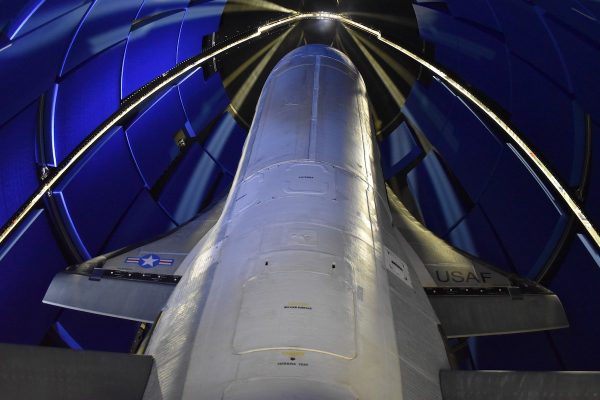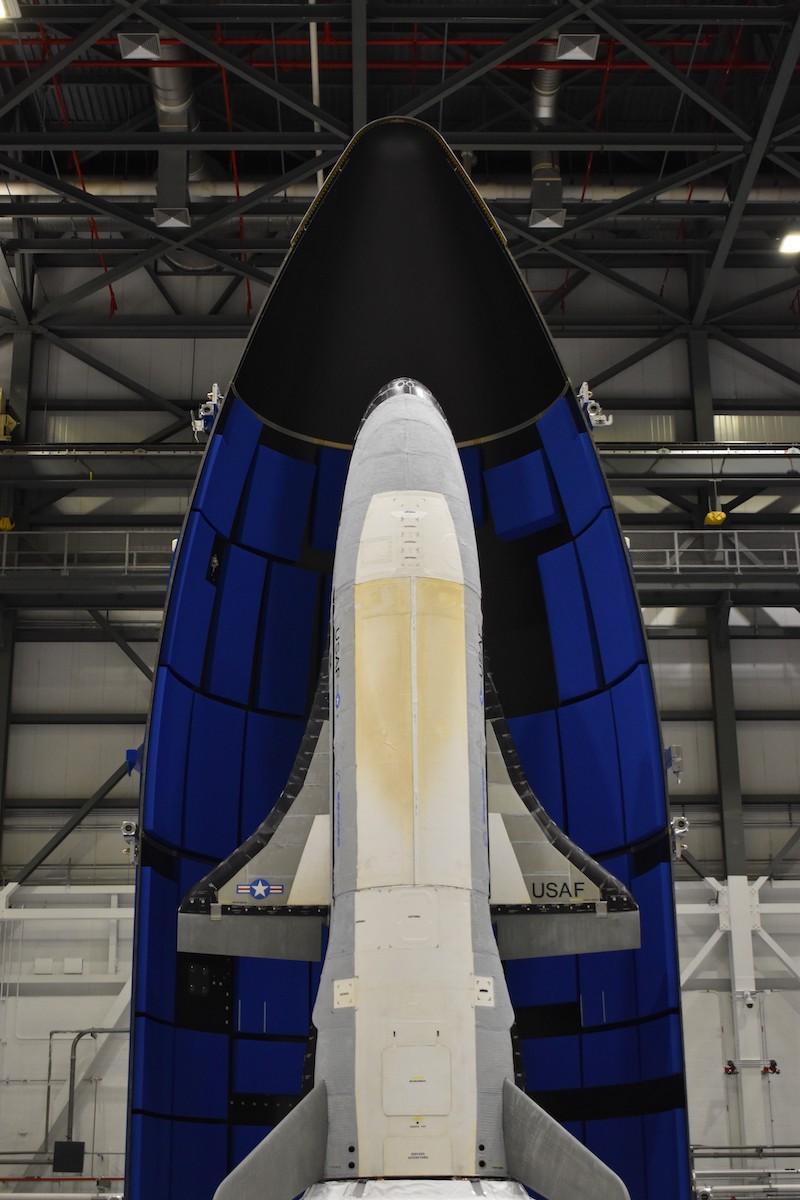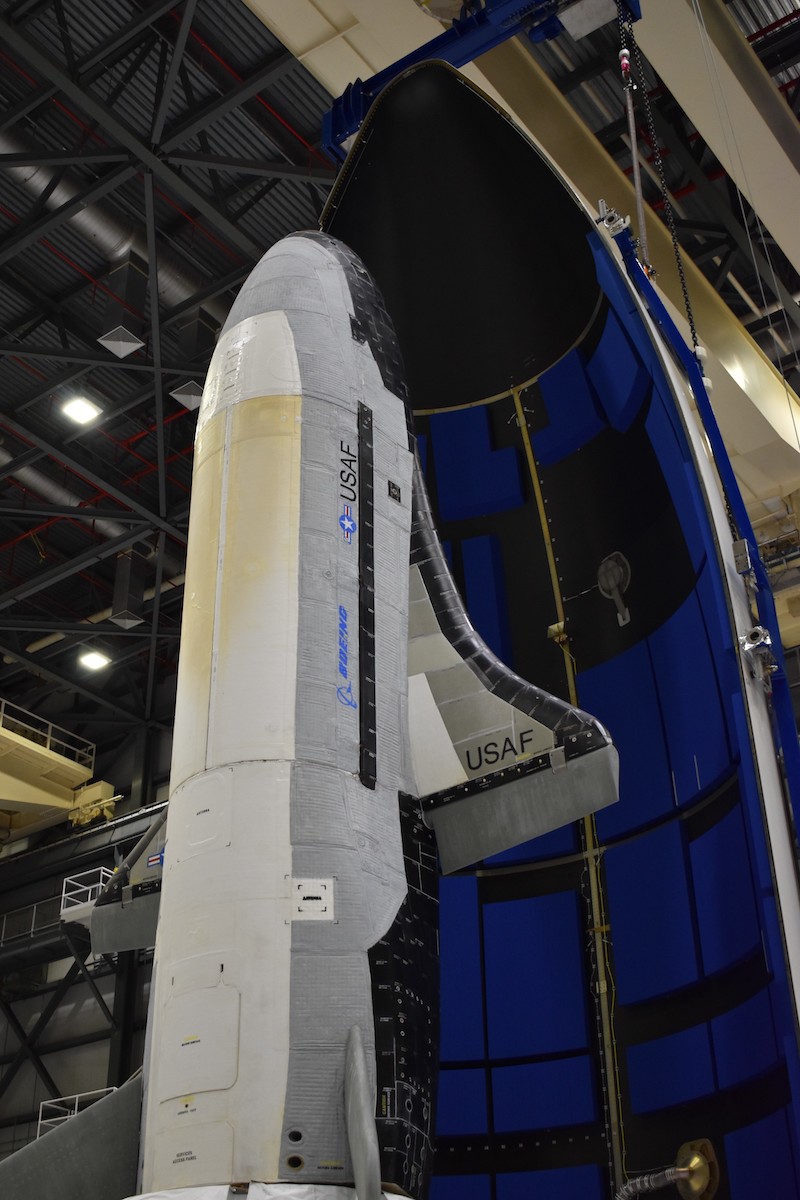Payloads revealed for next flight of X-37B military spaceplane – Spaceflight Now

The next flight of the U.S. military’s reusable X-37B spaceplane — scheduled for liftoff May 16 from Cape Canaveral — will carry more experiments into orbit than any of the winged ship’s previous missions, including two payloads for NASA and a small deployable satellite built by Air Force Academy cadets.
Military officials announced new details about the upcoming X-37B mission Wednesday, and confirmed its target launch date of May 16. The Boeing-built spaceplane was mounted on top of a United Launch Alliance Atlas 5 rocket Tuesday inside the Vertical Integration Facility at Cape Canaveral’s Complex 41 launch pad.
The unpiloted spacecraft launches inside a payload shroud on top of a conventional rocket, unfurls a power-generating solar array in orbit to generate electricity, and returns to Earth for a runway landing like NASA’s retired space shuttle.
“This sixth mission is a big step for the X-37B program,” said Randy Walden, director and program executive officer for the Air Force Rapid Capabilities Office. “This will be the first X-37B mission to use a service module to host experiments. The incorporation of a service module on this mission enables us to continue to expand the capabilities of the spacecraft and host more experiments than any of the previous missions.”
The service module is attached to the aft end of the X-37B spaceplane, providing additional capacity for experiments and payloads. The X-37B itself, measuring more than 29 feet (8.9 meters) long, also has a cargo bay inside its fuselage.
Secretary of the Air Force Barbara Barrett said Wednesday that the Air Force’s Rapid Capabilities Office is partnering with the U.S. Space force and the Air Force Research Laboratory on the next X-37B mission.
“In today’s age of electrons, space systems track storms, locate stranded motorists, timestamp credit card transactions, and monitor treaty compliance,” Barrett in a statement. “Demonstrating the department’s innovation, this X-37B mission will host more experiments than any prior missions. This launch also demonstrates the department’s collaboration that pushes the boundaries for reusable space systems.”
Barrett said the sixth upcoming flight “maximizes the X-37B’s unique capabilities.”
“This important mission will host more experiments than any prior X-37B flight, including two NASA experiments,” Barrett said Wednesday. “One is a sample plate evaluating the reaction of select significant materials to the conditions in space. The second studies the effect of ambient space radiation on seeds.”
The X-37B also carries a space-based solar power experiment.
“A third experiment designed by the Naval Research Laboratory transforms solar power into radio frequency microwave energy, then studies transmitting that energy to Earth,” Barrett said.

Once in orbit, the X-37B will also release a small satellite named FalconSat 8. Developed by Air Force Academy cadets in partnership with the Air Force Research Laboratory, the small satellite carries five experimental payloads. It will be operated by by the Air Force Academy’s Cadet Space Operations Squadron.
In a statement Wednesday, the Air Force said it “continues to push the flight envelope for the X-37B, and will build upon its growing collaboration with experiment partners with its sixth mission.”
Barrett said Wednesday the Air Force is declassifying some of the service’s space activities. The X-37B, which Barrett said was “previously cloaked in secrecy,” has logged 2,865 days in orbit on five previous missions.
The X-37B, also known as the Orbital Test Vehicle, remains an Air Force asset, officials said. The newly-established Space Force is responsible for the launch, on-orbit operations and landing.
“The ability to test new systems in space and return them to Earth is unique to the X-37B program and enables the U.S. to more efficiently and effectively develop space capabilities necessary to maintain superiority in the space domain,” the Air Force said in a statement.
Boeing has built two X-37B vehicles for orbital flights. The program began under NASA management before transferring to DARPA in 2004, then to the Air Force in 2006.
The first X-37B space mission launched in April 2010. Four of the previous X-37B flights have launched on ULA Atlas 5 rockets, and one lifted off on a SpaceX Falcon 9 launcher.
The sixth X-37B mission will fly on a version of ULA’s Atlas 5 rocket without any strap-on solid rocket boosters and a 17.7-foot-diameter (5.4-meter) payload fairing.

“Technologies being tested in the program include advanced guidance, navigation and control, thermal protection systems, avionics, high temperature structures and seals, conformal reusable insulation, lightweight electromechanical flight systems, advanced propulsion systems, advanced materials and autonomous orbital flight, reentry and landing,” Air Force officials wrote in an X-37B fact sheet.
“The X-37B team continues to exemplify the kind of lean, agile and forward-leaning technology development we need as a nation in the space domain,” said Gen. John “Jay” Raymond, the Space Force’s Chief of Space Operations. “Each launch represents a significant milestone and advancement in terms of how we build, test, and deploy space capabilities in a rapid and responsive manner.”
The fifth X-37B mission concluded with a landing at the Shuttle Landing Facility runway at the Kennedy Space Center in Florida. Boeing and military teams ready the reusable spaceplanes inside a former space shuttle processing facility at Kennedy.
Email the author.
Follow Stephen Clark on Twitter: @StephenClark1.






